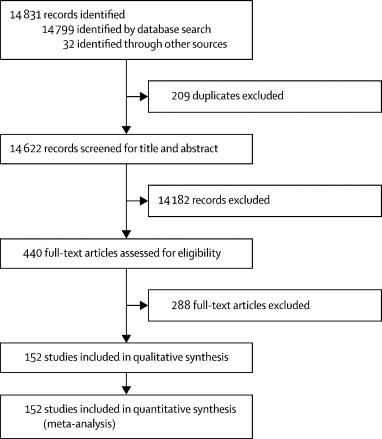The Lancet Psychiatry ( IF 30.8 ) Pub Date : 2020-03-24 , DOI: 10.1016/s2215-0366(20)30057-2 Cathy Davies 1 , Giulia Segre 1 , Andrés Estradé 2 , Joaquim Radua 3 , Andrea De Micheli 4 , Umberto Provenzani 5 , Dominic Oliver 6 , Gonzalo Salazar de Pablo 7 , Valentina Ramella-Cravaro 6 , Maria Besozzi 8 , Paola Dazzan 9 , Maddalena Miele 10 , Gianluigi Caputo 6 , Cecilia Spallarossa 6 , Georgia Crossland 6 , Athif Ilyas 6 , Giulia Spada 6 , Pierluigi Politi 8 , Robin M Murray 11 , Philip McGuire 12 , Paolo Fusar-Poli 13

|
Background
Prenatal and perinatal insults are implicated in the aetiopathogenesis of psychotic disorders but the consistency and magnitude of their associations with psychosis have not been updated for nearly two decades. The aim of this systematic review and meta-analysis was to provide a comprehensive and up-to-date synthesis of the evidence on the association between prenatal or perinatal risk and protective factors and psychotic disorders.
Methods
In this systematic review and meta-analysis, we searched the Web of Science database for articles published up to July 20, 2019. We identified cohort and case-control studies examining the association (odds ratio [OR]) between prenatal and perinatal factors and any International Classification of Diseases (ICD) or Diagnostic and Statistical Manual of Mental Disorders (DSM) non-organic psychotic disorder with a healthy comparison group. Other inclusion criteria were enough data available to do the analyses, and non-overlapping datasets. We excluded reviews, meta-analyses, abstracts or conference proceedings, and articles with overlapping datasets. Data were extracted according to EQUATOR and PRISMA guidelines. Extracted variables included first author, publication year, study type, sample size, type of psychotic diagnosis (non-affective psychoses or schizophrenia-spectrum disorders, affective psychoses) and diagnostic instrument (DSM or ICD and version), the risk or protective factor, and measure of association (primary outcome). We did random-effects pairwise meta-analyses, Q statistics, I2 index, sensitivity analyses, meta-regressions, and assessed study quality and publication bias. The study protocol was registered at PROSPERO, CRD42017079261.
Findings
152 studies relating to 98 risk or protective factors were eligible for analysis. Significant risk factors were: maternal age younger than 20 years (OR 1·17) and 30–34 years (OR 1·05); paternal age younger than 20 years (OR 1·31) and older than 35 years (OR 1·28); any maternal (OR 4·60) or paternal (OR 2·73) psychopathology; maternal psychosis (OR 7·61) and affective disorder (OR 2·26); three or more pregnancies (OR 1·30); herpes simplex 2 (OR 1·35); maternal infections not otherwise specified (NOS; OR 1·27); suboptimal number of antenatal visits (OR 1·83); winter (OR 1·05) and winter to spring (OR 1·05) season of birth in the northern hemisphere; maternal stress NOS (OR 2·40); famine (OR 1·61); any famine or nutritional deficits in pregnancy (OR 1·40); maternal hypertension (OR 1·40); hypoxia (OR 1·63); ruptured (OR 1·86) and premature rupture (OR 2·29) of membranes; polyhydramnios (OR 3·05); definite obstetric complications NOS (OR 1·83); birthweights of less than 2000 g (OR 1·84), less than 2500 g (OR 1·53), or 2500–2999 g (OR 1·23); birth length less than 49 cm (OR 1·17); small for gestational age (OR 1·40); premature birth (OR 1·35), and congenital malformations (OR 2·35). Significant protective factors were maternal ages 20–24 years (OR 0·93) and 25–29 years (OR 0·92), nulliparity (OR 0·91), and birthweights 3500–3999 g (OR 0·90) or more than 4000 g (OR 0·86). The results were corrected for publication biases; sensitivity and meta-regression analyses confirmed the robustness of these findings for most factors.
Interpretation
Several prenatal and perinatal factors are associated with the later onset of psychosis. The updated knowledge emerging from this study could refine understanding of psychosis pathogenesis, enhance multivariable risk prediction, and inform preventive strategies.
Funding
None.
中文翻译:

精神病的产前和围产期风险和保护因素:系统评价和荟萃分析。
背景
产前和围产期的侮辱与精神病的发病机制有关,但它们与精神病的关联的一致性和程度近二十年都没有更新。本系统评价和荟萃分析的目的是对产前或围产期风险和保护因素与精神障碍之间关联的证据进行全面和最新的综合。
方法
在这项系统评价和荟萃分析中,我们在 Web of Science 数据库中搜索了截至 2019 年 7 月 20 日发表的文章。我们确定了队列和病例对照研究,这些研究检查了产前和围产期因素之间的关联(比值比 [OR])和任何国际疾病分类 (ICD) 或精神障碍诊断和统计手册 (DSM) 非器质性精神障碍与健康对照组。其他纳入标准是有足够的数据可用于进行分析,并且数据集不重叠。我们排除了评论、荟萃分析、摘要或会议记录,以及具有重叠数据集的文章。根据 EQUATOR 和 PRISMA 指南提取数据。提取的变量包括第一作者、出版年份、研究类型、样本量、精神病诊断的类型(非情感性精神病或精神分裂症谱系障碍、情感性精神病)和诊断工具(DSM 或 ICD 和版本)、风险或保护因素以及相关性测量(主要结果)。我们进行了随机效应成对荟萃分析、Q 统计、I 2指数、敏感性分析、元回归以及评估的研究质量和发表偏倚。研究方案在 PROSPERO 注册,CRD42017079261。
发现
涉及 98 个风险或保护因素的 152 项研究符合分析条件。重要的危险因素是: 母亲年龄小于 20 岁 (OR 1·17) 和 30-34 岁 (OR 1·05);父亲年龄小于 20 岁(或 1·31)且大于 35 岁(或 1·28);任何母亲 (OR 4·60) 或父亲 (OR 2·73) 精神病理学;产妇精神病 (OR 7·61) 和情感障碍 (OR 2·26);3 次或更多次怀孕 (OR 1·30);单纯疱疹 2 (OR 1·35); 未另行说明的母体感染(NOS;或 1·27);次优的产前检查次数 (OR 1·83);北半球的冬季(OR 1·05)和冬季到春季(OR 1·05)的出生季节;产妇压力 NOS (OR 2·40); 饥荒(或 1·61);怀孕期间出现任何饥荒或营养不良 (OR 1·40);产妇高血压(OR 1·40);缺氧 (OR 1·63); 膜破裂(OR 1·86)和早破(OR 2·29);羊水过多 (OR 3·05); 明确的产科并发症 NOS (OR 1·83);出生体重小于 2000 克(或 1·84)、小于 2500 克(或 1·53)或 2500–2999 克(或 1·23);出生身长小于 49 厘米(或 1·17);小于胎龄儿 (OR 1·40);早产(OR 1·35)和先天性畸形(OR 2·35)。重要的保护因素是母亲年龄 20-24 岁(或 0·93)和 25-29 岁(或 0·92)、未生育(或 0·91)和出生体重 3500-3999 克(或 0·90)或以上超过 4000 克(或 0·86)。对结果进行了发表偏倚校正;敏感性和元回归分析证实了这些发现对大多数因素的稳健性。出生体重小于 2000 克(或 1·84)、小于 2500 克(或 1·53)或 2500–2999 克(或 1·23);出生身长小于 49 厘米(或 1·17);小于胎龄儿 (OR 1·40);早产(OR 1·35)和先天性畸形(OR 2·35)。重要的保护因素是母亲年龄 20-24 岁(或 0·93)和 25-29 岁(或 0·92)、未生育(或 0·91)和出生体重 3500-3999 克(或 0·90)或以上超过 4000 克(或 0·86)。对结果进行了发表偏倚校正;敏感性和元回归分析证实了这些发现对大多数因素的稳健性。出生体重小于 2000 克(或 1·84)、小于 2500 克(或 1·53)或 2500–2999 克(或 1·23);出生身长小于 49 厘米(或 1·17);小于胎龄儿 (OR 1·40);早产(OR 1·35)和先天性畸形(OR 2·35)。重要的保护因素是母亲年龄 20-24 岁(或 0·93)和 25-29 岁(或 0·92)、未生育(或 0·91)和出生体重 3500-3999 克(或 0·90)或以上超过 4000 克(或 0·86)。对结果进行了发表偏倚校正;敏感性和元回归分析证实了这些发现对大多数因素的稳健性。重要的保护因素是母亲年龄 20-24 岁(或 0·93)和 25-29 岁(或 0·92)、未生育(或 0·91)和出生体重 3500-3999 克(或 0·90)或以上超过 4000 克(或 0·86)。对结果进行了发表偏倚校正;敏感性和元回归分析证实了这些发现对大多数因素的稳健性。重要的保护因素是母亲年龄 20-24 岁(或 0·93)和 25-29 岁(或 0·92)、未生育(或 0·91)和出生体重 3500-3999 克(或 0·90)或以上超过 4000 克(或 0·86)。对结果进行了发表偏倚校正;敏感性和元回归分析证实了这些发现对大多数因素的稳健性。
解释
一些产前和围产期因素与精神病的较晚发作有关。从这项研究中获得的最新知识可以加深对精神病发病机制的理解,增强多变量风险预测,并为预防策略提供信息。
资金
没有任何。











































 京公网安备 11010802027423号
京公网安备 11010802027423号